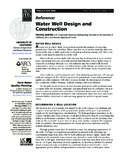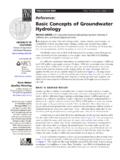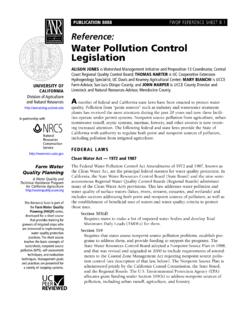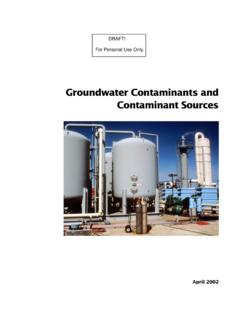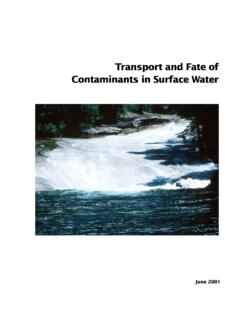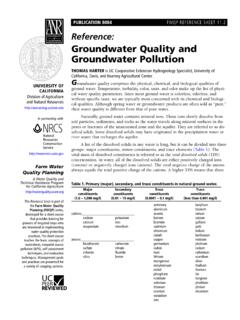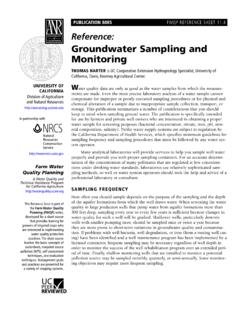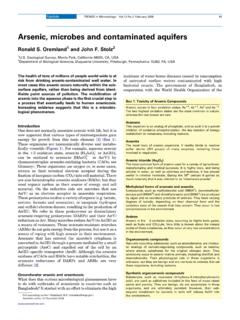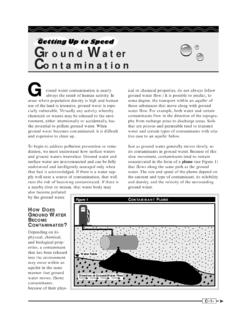Transcription of Groundwater Quality and Groundwater Pollution
1 Reference: Groundwater Quality andGroundwater PollutionTHOMAS HARTERis UC Cooperative Extension Hydrogeology Specialist, University ofCalifornia, Davis, and Kearney Agricultural Quality comprises the physical, chemical, and biological qualities ofground water. Temperature, turbidity, color, taste, and odor make up the list of physi-cal water Quality parameters. Since most ground water is colorless, odorless, andwithout specific taste, we are typically most concerned with its chemical and biologi-cal qualities. Although spring water or Groundwater products are often sold as pure, their water Quality is different from that of pure , ground water contains mineral ions.
2 These ions slowly dissolve fromsoil particles, sediments, and rocks as the water travels along mineral surfaces in thepores or fractures of the unsaturated zone and the aquifer. They are referred to as dis-solved solids. Some dissolved solids may have originated in the precipitation water orriver water that recharges the list of the dissolved solids in any water is long, but it can be divided into threegroups: major constituents, minor constituents, and trace elements (Table 1). Thetotal mass of dissolved constituents is referred to as the total dissolved solids (TDS)concentration.
3 In water, all of the dissolved solids are either positively charged ions(cations) or negatively charged ions (anions). The total negative charge of the anionsalways equals the total positive charge of the cations. A higher TDS means that thereIn partnership Farm Water Quality PlanningA Water Quality and Technical Assistance Program for California Agriculture REFERENCESHEETis part ofthe Farm Water QualityPlanning (FWQP)series,developed for a short coursethat provides training for growers of irrigated crops whoare interested in implementingwater Quality protection practices.
4 The short courseteaches the basic concepts ofwatersheds, nonpoint sourcepollution (NPS), self-assessmenttechniques, and evaluation techniques. Management goalsand practices are presented fora variety of cropping 8084 FWQP REFERENCE SHEET OF CALIFORNIAD ivision of Agriculture and Natural 1. Primary (major), secondary, and trace constituents in natural ground SecondaryTraceTraceconstituentsconstitue ntsconstituentsconstituents( 1,000 mg/l)( 10 mg/l)( mg/l) (less than mg/l)antimonyberylliumaluminumbismuthcat ions:_____arsenicceriumsodiumpotassiumba riumcesiumcalciumironbromidegalliummagne siumstrontiumcadmiumgoldchromiumindiumco baltlanthanumanions.
5 _____copperniobiumbicarbonatecarbonatege rmaniumplatinumsulfatenitrateiodideradiu mchloridefluorideleadrutheniumsilicaboro nlithiumscandiummanganesesilvermolybdenu mthalliumnickelthoriumphosphatetinrubidi umtungstenseleniumytterbiumtitaniumyttri umuraniumzirconiumvanadiumzincare more cations and anions in the water. With more ions in thewater, the water s electrical conductivity (EC) increases. By measur-ing the water s electrical conductivity, we can indirectly determine itsTDS concentration. At a high TDS concentration, water becomessaline.
6 Water with a TDS above 500 mg/l is not recommended foruse as drinking water (EPA secondary drinking water guidelines).Water with a TDS above 1,500 to 2,600 mg/l (EC greater than 4 mmho/cm) is generally considered problematic for irrigationuse on crops with low or medium salt for natural organic matter originating from topsoils,all of these naturally occurring dissolved solids are inorganiccon-stituents: minerals, nutrients, and trace elements, including tracemetals. In most cases, trace elements occur in such low concentra-tions that they are not a threat to human health.
7 In fact many ofthe trace elements are considered essential for the human metabo-lism. In Europe, water from springs and wells with certain levels oftrace elements has long been considered a remedy for health spas usually are located near such areas. High con-centrations of trace metals can also be found in ground water nearcontaminated sources, however, posing serious health trace constituents that are associated with industrial pollu-tion, such as arsenic and chromium, may also occur in completelypristine ground water at concentrations that are high enough tomake that water unsuitable as drinking matter is also a natural constituent of ground as microbes are ubiquitous in the environment around us, theyare very common in the subsurface.
8 Including ground increasingly rely on these, for instance, for subsur-face bioremediation of contaminated ground activities can alter the natural composition of Groundwater through the disposal or dissemination of chemicals andmicrobial matter at the land surface and into soils, or throughinjection of wastes directly into ground water. Groundwater pollu-tion (or Groundwater contamination) is defined as an undesirable change in groundwa-ter Quality resulting from human activities (for more information on nonpoint sourcepollution from agricultural activities, see Nonpoint Sources of Pollution in IrrigatedAgriculture[UC ANR Publication 8055]).
9 The EPA s drinking water program ( ) defines accept-able levels of both inorganic and organic Groundwater constituents and of microbialmatter, as well as other Groundwater Quality factors. Groundwater Pollution works differently from surface water Pollution , althoughthey have many sources in common, such as fertilizers, pesticides, and animal important concepts should be kept in mind:1. Unlike surface water, ground water does not typically flow toward a singleoutlet at the topographic bottom of the watershed, where the cumulative effectof watershed Pollution and of improvements in watershed management can bedirectly measured.
10 Groundwater discharge depends on topography (mountain-ous, hilly, or flat), hydrogeology (confined or unconfined aquifers, fracturedrock or sediments, aquifer geometry), the sources of Groundwater recharge2 ANR Publication 8084 CONVERSIONSAll concentrations are measured in:milligrams per liter (mg/l)micrograms per liter ( g/l)To convert between the two:1,000 g/l = 1 mg/lAlso used to measure concentrationare the units parts per billion (ppb)and parts per million (ppm). Forgeneral purposes, one can use thefollowing very simple conversion:1 ppb 1 g/l1 ppm 1 mg/lTo convert TDS to electrical conduc-tivity (a measure of salinity): The TDS concentration in mg/l isapproximately 65 percent of theelectrical conductivity value in S/cmor in mho/cm.
